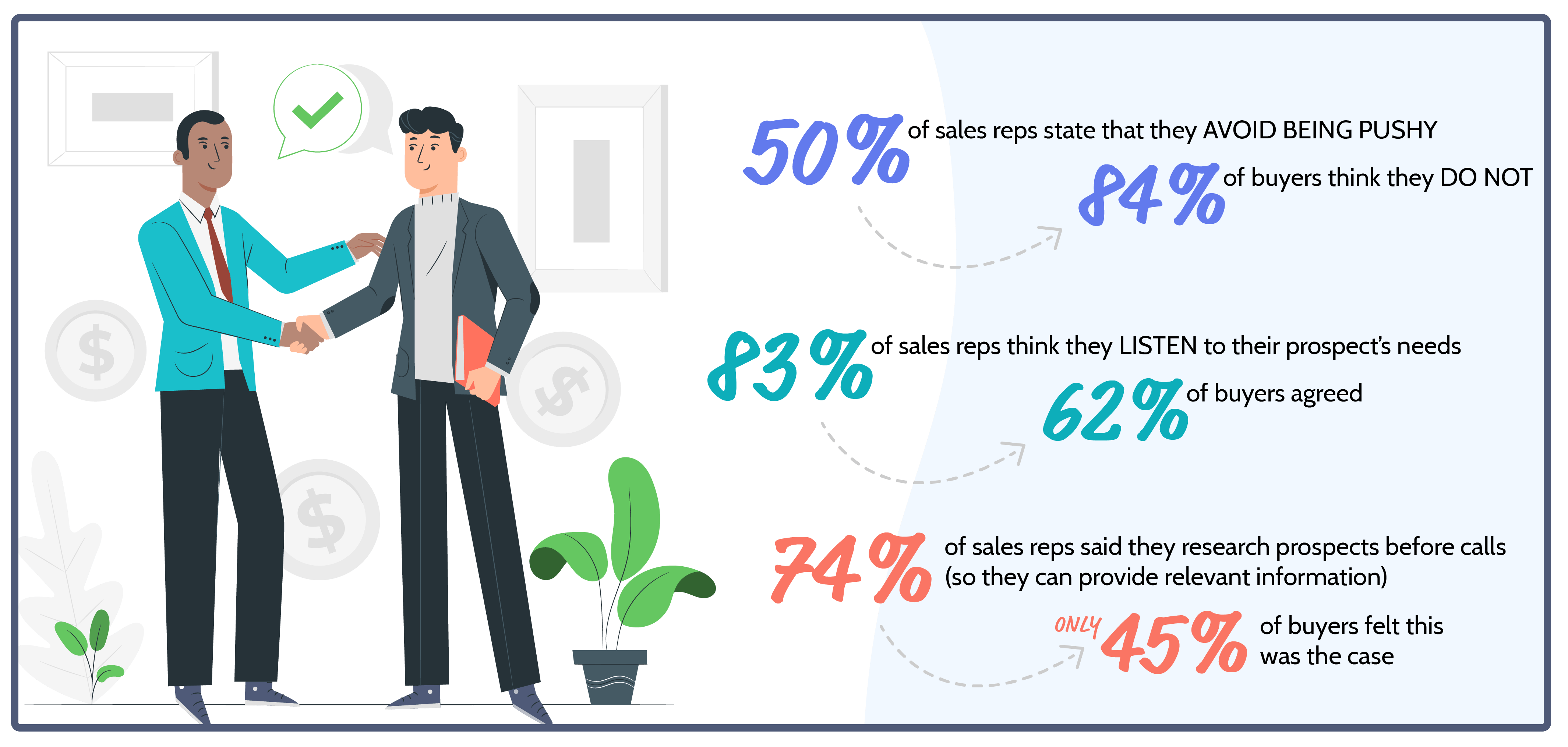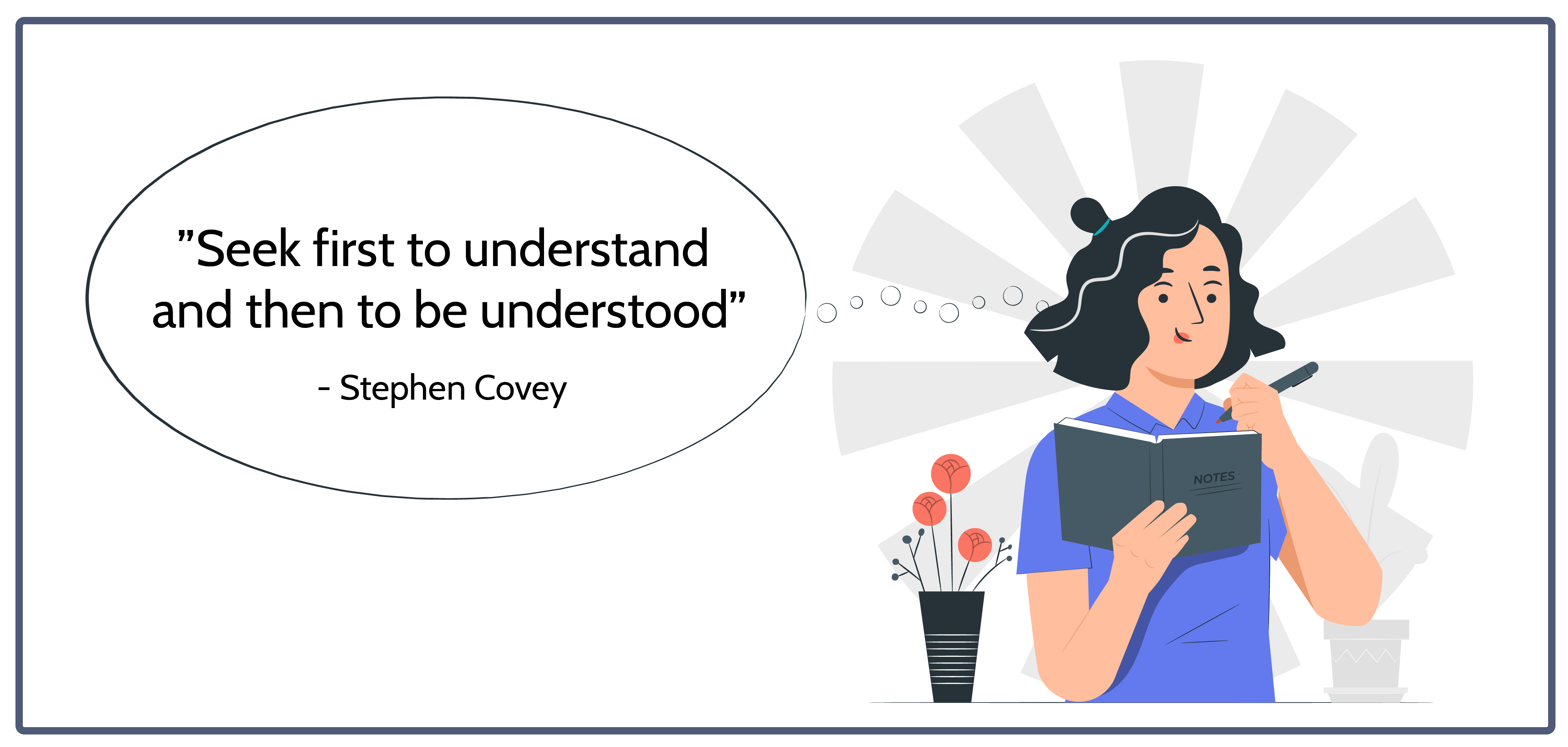Over time, the role of sales personnel has grown, developed, and diversified. While earlier, sales reps may have sold goods out of suitcases or the trunks of their vehicles, the modern-day sales reps have a wealth of techniques and tools that make sales more efficient.
Successful sales leaders are selling what they genuinely think can resolve the issues and needs of their buyers. And that is what consultative selling is all about.
What Is Consultative Selling?
Consultative selling is an investigative approach. Instead of asking prospects what they need, you ask thought-provoking questions that help them explore their pain areas and build trust in your brand.
At the end of the day, with a consultative sales strategy, prospects will be motivated to make the best decisions themselves.
Your job as a sales rep is to be empathetic and supportive, supplying prospects with the knowledge they need to make an informed purchasing decision.
Consultative sales stand in stark contrast to transactional sales. Transactional sales are primarily about the attainment of revenue goals. Consultative sales, though still involved in achieving revenue goals, seek to achieve these goals by helping customers excel. And it makes a big difference.
When you have a consultative sales strategy, you evaluate success through the impact you have on your potential buyers, the results they obtain, and their long-term success. You base your message on this data, not on your product features and benefits. You never consider the customer as a sales number. Instead, you become a reliable advisor.
The Current Scenario
According to the customers, the three most critical aspects of great sales experience are a sales rep who 1) listens to their needs, 2) is not pushy, and 3) offers relevant information.
This isn’t too much to ask, right?
It may not seem like that, but statistics reveal that while sales reps appear to know what customers want, there is a big difference between their self-image and the customer’s viewpoint.
Given the above eye-opening statistics, it’s clear that knowing your prospects and avoiding traditional pushy selling techniques are the two crucial things to do.
Consultative Selling vs Solution Selling
The main difference between consultative selling and solution selling is consultative selling is a sales approach that focuses on understanding the customer’s needs and providing personalized solutions to meet those needs. This approach emphasizes building a relationship with the customer and becoming a trusted advisor. Solution selling, on the other hand, is a sales approach that involves identifying a problem the customer is facing and offering a specific product or service as a solution to that problem. This approach tends to be more product-focused and solution-oriented.
Taking the Right Consultative Approach to Earn Trust and Close More Deals
Consultative selling is not the easiest way for sales managers and their teams, but the results can be impressive. If the sales team needs to be more consultative, these are some of the best strategies to implement.
Do Your Research
There’s more to understanding the buyer’s outlook than simply having them answer a couple of questions. In consultancy sales, you need to collect a lot of details about and from your buyer before you sell to them, so you understand what they need and why they’re talking to you.
That’s the essence of consultative selling. It’s about being in the mind of the prospect: their pains, anxieties, concerns, and desires.
How can you do this? By using the B2B data such as technographics, firmographics, and buyer intent data. Or by asking investigative questions at the initial stage of the sales process.
Whatever you plan to do, the research will help.
Qualifying the Prospects
Is this person likely to be involved in your product or service? Does it fit with what they’re doing? Can you think about how it could help them?
If “yes,” does that person have the right to buy? If no, is there anyone else in the business you like to speak to instead?
Provide Starting Points for Conversations
Consultative selling allows you to have a dialogue with your prospects. Not merely to deliver a sales pitch. The more you know about your clients, the better to begin discussions that engage them and eventually lead to a sale.
Back-Up Conversations with Custom Insights
Show prospects why they need your product with observations (i.e. facts and statistics, or expertise and case studies) customized to their particular circumstances such as size or industry.
Understand the Competition
If you know what other products your potential buyers may consider, you can see if and how your product can better suit their needs.
For instance, imagine you are selling a CRM, and you know that your main competitor is Salesforce. Technographic data will help you identify the companies that are currently using Salesforce, and firmographic data can help you see companies that are smaller and would like to save money on a CRM. This will help you identify your potential buyers and save a lot of time in research.
Ask Questions
Understanding the needs of a prospect is key to consultative selling, but the only way you can even try to consider them properly is to ask the right questions.
Until you make the call or meet with a prospect, make a list of “generic” questions that you can use to launch a dialogue and, if necessary, fall back on. You need to be able to think on your feet and pose custom questions based on the prospect’s answers.
Keep in mind that prospects are likely to be hurried and able to answer only a few questions, so pick carefully.
Exactly what these questions are will depend on the product you’re selling; however, a good thumb rule is to use “empathetic” and “investigative” questions, and avoid “trap” questions. If you ask something like “Are you happy with X product?” and your prospect says yes, you are going nowhere. Avoid questions that have simple yes or no answers. You want to get them talking.
You should ask questions like:
“How does XYZ impact your business? “What’s keeping the business from reaching its goals? “And” What’s the current solution that isn’t giving you the ROI right now? You can also submit “umbrella questions” – questions used to obtain more general knowledge from the prospect.
Improve Your Active Listening Skills
Few of us are naturally experienced at active listening. Instead, we listen “passively.” This means we hear what people say, but we don’t truly register the implications or interpret it critically.
This hurts our ability to recall conversations and to meet the needs of a prospect.
Active listening is one of the first skills HubSpot teaches to new salespeople, and why research shows that the top salespeople spend a lot more time listening than talking.
To get better at active listening, you need to work not just on interpreting the words that a potential prospect has to say to you, but on the context behind them.
Specifically, this includes:
Shutting up and really listening: To listen actively, you must be quiet and pay complete attention to the other person. Never disturb their speaking. Wait till they come to an end, think about what they said, and then react.
Taking time to process what someone says: Most of the sales reps dislike conversational lulls or what we see as awkward silences. As a result, they are not attentive to what anyone is saying, since they are so busy worrying about what they are going to say next.
Clarifying what’s been said to you: You don’t need to clarify everything they say. But anytime you speak to a prospect, and they say something important, reiterate it back to them and make sure you’re both on the same page.
This does two things:
- It makes you recall the key points of your conversation.
- It shows the prospect that you’re actually listening.
Add Value First
It’s quick to slide back into transactional sales — even if you’re dedicated to consultative selling. When revenue figures are down, a transactional approach to sales may seem to be the correct option. Remember, as that happens, consumers are searching for sales staff they can trust.
That’s why it’s so important to keep focused on adding value. If you concentrate on selling first, you might close some deals faster. But what about the future? Consultative selling is about first offering value, knowing that the transaction will proceed, and a long-term relationship will grow.
You will be good at thinking out-of-box. There is rarely a one-size-fits-all solution, and the willingness to listen to the prospect’s needs and come up with a tailored solution will set you apart from the competition.
Most of all, if you don’t have the perfect solution, you ought to be able to recommend someone else — knowing that you may be the perfect fit at another time. And, at the end of the day, if you don’t add real practical value, then you’re not a good fit for them.
Train Your Team on Conversation Qualifiers
When you’re trying to develop a consultative sales mechanism into the sales cycle, these qualifiers are implicit but invaluable to the overall discussion. They show that you actually listen and communicate, and have clarification that helps the discussion move forward.
The only way to consciously improve is to listen to the team’s sales calls for consultative qualifying.
- How are your reps asking for context?
- Do they listen more than they speak?
- What precise words do they use?
- Keep in mind that a consultative business model does not sound like an investigation.
Reps should read through their sales pitch and questions and practice different situations.
These are the things you need to train your staff on. That’s how you build a community of sales consultancy.
Get Started With Consultative Selling
As a salesperson, it’s difficult to ask consultative selling questions in any conversation. Particularly, if you’re already sure that your product addresses the pain point of the prospect.
Yet applying these techniques to your sales process ensures the stable growth of revenue by making sure that you find the right solution with the right people.
If you are to drive more sales with a consultative approach, you need to decide where you should start. SalesIntel helps you to set the foundation by providing essential human-verified data, so that can spend more time selling and close more deals.







